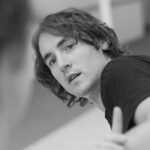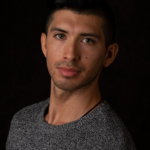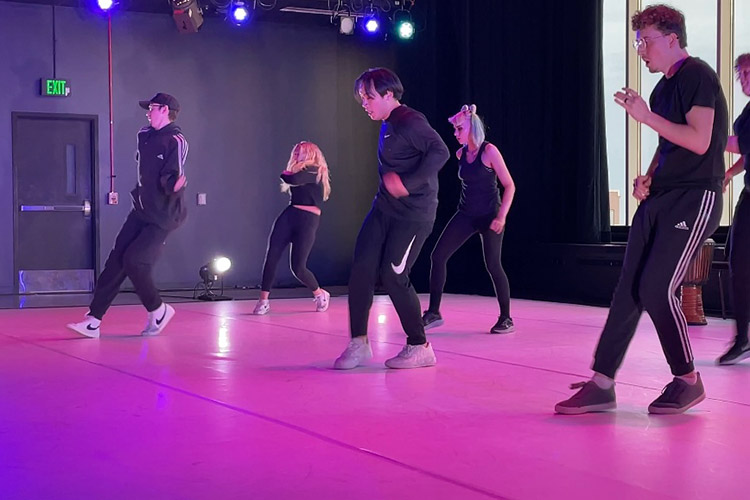Faculty member and Springdances artistic director Dan Schuchart and guest artist Alfonso Cervera reflect on the artist-in-residency program and what sets it apart from others
The Department of Dance is gearing up for Springdances: Elemental in May. Work on the concert began well before the spring semester during a one-week intensive with guest artist Alfonso Cervera, a Queer first generation Mexicano/a/x choreographer, performer, educator, curator, and activist. Faculty member and Springdances artistic director Dan Schuchart and Cervera reflect on the artist-in-residency program and what sets it apart from others.
What is unique about the model that Department of Dance has for their guest artist in residence program?

Dan Schuchart: In other programs, guest artist engagement can often be a quick, condensed experience. Our guest artists have an extended interaction with our students that crosses semesters and offers many modes of sharing. The Department of Dance first brings the guest artist in for a one-week teaching residency. During this time their dance research is shared in technique classes, improvisation, composition, and other academic courses. All the Dance majors take classes with the guest artist and the artist really gets to know our students. At the end of the teaching residency there is an audition for the dance that will be made the following semester. The new choreography is created in a one-week intensive before the term begins, rehearsing 7 hours per day. This week is rigorous and rewarding. The dance is then rehearsed over the semester with a faculty rehearsal director who stays in contact with the guest artist. When the work is finally performed the movement vocabulary and group dynamic have settled into the students’ bodies, the dance is known at a deeper level because of the time invested, and the performance is a celebration of that investment.
In what ways do students benefit from their work with a guest artist?
Dan: The students are exposed to new dance techniques, forms, histories, and approaches that expand on what the Department of Dance offers. As a department, we work hard to place dance in the larger context of how movement circulates in the world and has agency in meaning-making, community building, and as a cultural signifier. The guest artist is a key component of this mission, sharing their dance research, pedagogical approach, and embodied practice. In addition, the guest offers networking opportunities to other dance communities and models for a sustainable life as an artist. Making art is a bit of alchemy too! The students involved in the choreographic process get to see how the artist develops movement, engages themes, and thinks compositionally which then offers ways of working for those students to fold into their artistic practice.
You are known for your technique, Poc-Chuc. Can you tell us a little about it?

Alfonso Cervera: Poc-Chuc is a technique that began to cultivate itself during my graduate studies at the University of California, Riverside. It was here that I wanted to pose questions and acknowledge how my lived experience as a Queer Mexican American practitioner of various dance techniques was informing my movement and choreographic choices. Poc-Chuc is an idea, an imaginative platform that allows Mexican Ballet Folklorico, Afro-Latin social dances, and Release Technique (Modern Dance) to weave and create a conversation of work that revels between various politics and socialities of tradition and contemporary dualities. It’s a strategy that allows for movement invention, transformation of the self using Latine Queer Techniques, and my lived experience to bring Mexicanidad into a space that pays homage to family and forms. It’s a form that I have investigated for about seven years now and it has been a tool that has helped to build community, create relationships across demographics and identities, and to create works that fit those communities during that time. It’s a style of work that differs every time something is created as a solo, duet, or ensemble.
How did you approach choreographing and casting Springdances?
Alfonso: Honestly, casting is so hard for me at times because I fall in love with everyone’s heart and spirit as they take on partner work, foot syncopation, and rhythms that call for vulnerability and the making of joy. In this casting, what was important for me was to find a group of movers that were individually distinct, but who could also complement one another. Those you can tell are working through understanding the histories of the zapateado footwork and who are also willing to take risk in learning material at a fast pace. My approach to choreographing this work was very different for me in terms of process, movement invention, and in exchanging internal dialogue with the participants in the space. A huge part of my process was inviting and collaborating with Cody Jensen, who’s an amazing musician and accompanist for my classes at the University of Illinois, Urbana-Champaign. I had asked Cody to create a sound score that took on different realms that are non-linear, but re-imagined sounds of Mexican Ballet Folklorico, Cumbia, abstraction, and from my days visiting Merida, Yucatan with my family. This choreographic process was different for me because I stepped into the room without a devised choreographic plan. The only thing planned was to play the sound created by Cody on the first day of us meeting and allowing that to inform the impetus of movement, storytelling, and a response to ideas and iconography. I guess you can say it was a moment of choreographing instinctually and taking into consideration who was in the cast and how to highlight each one as an individual and as an ensemble. This specific process will forever be engrained in my heart because it was such a heartwarming experience.
What have been some of the highlights of working with UWM students during your residency?
Alfonso: First off, I think it’s important that I give a shout out to all the dancers who stepped inside my process for the week and who supported the vision of bringing different realms to life. I also would like to thank Gina who was my assistant during my time there and who continues to rehearse with them. Love you all. Something that I think is powerful at UW-Milwaukee is the “yes” attitude of the movers and the wanting to do their very best every moment. I’ve had the honor of being at other residencies choreographing on students, but the Milwaukee community has always been open to experimentation, risk taking, and diving into the work by bringing in their whole humble selves. I truly appreciate the week I had with these dancers and the students in the classes I taught as they will be the new art change makers of the next generation.
What excites you most about the Springdances concert in May?
Dan: It will be exciting to showcase the student’s hard work. The focus and dedication to their craft and artistry have been exceptional. I’m also very excited to share all the collaboration that is in this production. There are big set pieces, props that fill the stage, and video projections. Original music was composed for three of the dances and live music will be performed by Andy Miller and Allen Russell (UWM alumni). It’s going to be an amazing show, thematically rich and a feast for the senses!
Alfonso: I think what excites me is being able to see everyone’s work on the main stage. I’m such a fan of everyone in the department and have always appreciated the works created because they are filled with such thought and imagination. However, I’m more than excited to see the dancers perform in May since they have continued to rehearse with Gina since my last departure. There is something that happens when lights and costuming go into the space and work as I want to see it in its full fruition.
